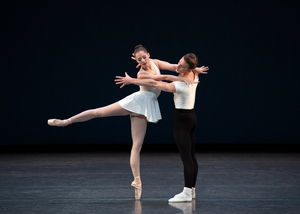BWW Dance: Worthy Ballets Reveal City Ballet at Its Best

Erin Baiano; photographer
What a difference proper programming can make. February 6th's NYCB Classic's I featured an absolute gem, a muted study in neoclassicism à la Robbins, a Balanchine modern masterpiece, and one of Justin Peck's stunners. The only questions were: why can't more evenings at City Ballet look like this, and what was up with the tempo?
Regarding the need for speed, both Concertino and Episodes were rendered mute by their reduced tempos. The former offered impressive solos and a Robbins' pas de trois in a steely vein. Sounds interesting enough, and compositionally it was, but at the musical andante conducted by Daniel Capps, the audience was treated to a placid affair. Concertino's undergirding excitement manifested solely through Jovani Furlan's performance, who imbued his every step with a smoldering tension. Despite their excellent dancing, Teresa Reichlen and Adrian Danchig-Waring were wan in contrast.
As to Episodes, it was an episodic affair of beautiful geometry but nothing to shock or awe. Blasphemy, I know. As with Concertino, the orchestra's languid speed and forbearance in attacking Webern's score deprived the ballet of all bite. Balanchine and speed; the two go hand in hand. The former without the latter is an array of posé, posé, posé. This lackluster effect was dispelled during Episodes' fascinating pas de deux and solo.
Ask la Cour and Claire Kretzschmar beautifully embodied the co-dependent aspects of Five Pieces. He is a grown man playing with a floppy doll who mimics his effect when they are apart but folds over him whenever they come together. It is another of Balanchine's ballets wherein the woman appears dependent upon the man. Still, the specific manipulations of their dancing reveal that she is actually the ringmaster, keeping him enthralled. Both looked fantastic together, particularly with La Cour's giant black unitard clad frame towering over her luminescence. After she folds over him and becomes his horns, one is left wondering, "Has he been cuckolded?"
The triumph of the ballet was Michael Trusnovec in the solo created for Paul Taylor. When he performed it at the Taylor Gala this past autumn, Trusnovec was more Ariel taking flight than Caliban struggling in the muck. His jumps were sprightly, and his arabesque radiated like an exemplar of Apollonian ideals; it was beautiful dancing, but it belonged to another ballet. At this performance, he looked as if he remembered that Taylor was still dancing with Graham at this point in his career and would have had more weight and contraction pulling at his core. If Trusnovec's athletic attributes were more grounded this time around, it is only because he was affecting to spring off something that offered him zero traction. If you have ever seen a bird crash into a bog and attempt to extricate itself from the mire with no success, then you recognized Trusnovec as he folded in on and dragged himself across the stage. It was hideously gorgeous. At curtain call, all bravos belonged to him.
The evening closed with Peck's masculine take on Aaron Copeland's Rodeo but in four episodes. Really, it is only three episodes because his interstitial pas de deux is not a real pas at all. Now that Peck is married, maybe his next ballet will offer us something more substantial when it comes to the relationship between a man and a woman. For now, this romping ballet is another play on one of Robbins' "we're just kids" dances, but in the vein of "we're just a swell of guys," and it is fantastic. Caiman Webber--a new corps man--completed the leading trio with Daniel Ulbricht and Anthony Huxley, who were as excellent as ever. Though Webber was off musically, the construction and compilation of nifty tricks in this piece are such that it did not matter.
And what of the opening? Haieff Divertimento is an absolute marvel. It offers its leading man little to do besides support his ballerina and reach off into the distance, which Harrison Ball accomplished handsomely. The ballet's main feature lies in its male variations, which started off strangely for Kennard Henson (his entrechats did not beat, and that double pirouette looked more like one and a half revolutions with a chug). Still, upon returning to the stage for a second round, he and his fellows dropped the nerves and dispatched their tricky feats (pirouettes that switched the retiré front with back and a fantastic variation of petit jetés) with aplomb. The women were fine, though their union was nowhere to be found. Strangely, the demi-soloists were allowed to show off their extension with such violent deviation. Dancers do not have to look like wallpaper, but they should move as if they belong to the same unit when performing; these women were all over the place.
As Haieff's ballerina, Unity Phelan was physically resplendent. The ballet's central pas de deux is essentially an extended adage which she deployed with exquisite grace--her développé devant was never less than 170 degrees and every extension flowed from her effortlessly--and yet, there was something muted about her effect. It was not the tempo this time around; fascinatingly, Capps conducted Rodeo and Haieff perfectly. Phelan is blessed with impeccable technique and astonishing pliancy in her facility, but as of yet she does not radiate the quiet holiness or natural sense of authority that a role like this demands. Either she requires greater maturity or better coaching. One hopes that she attains both with due haste.
Comments
Videos

